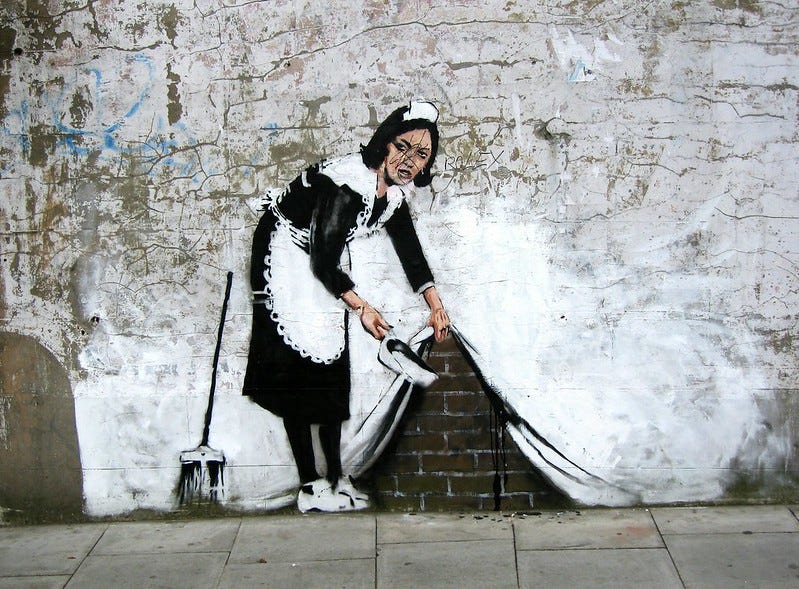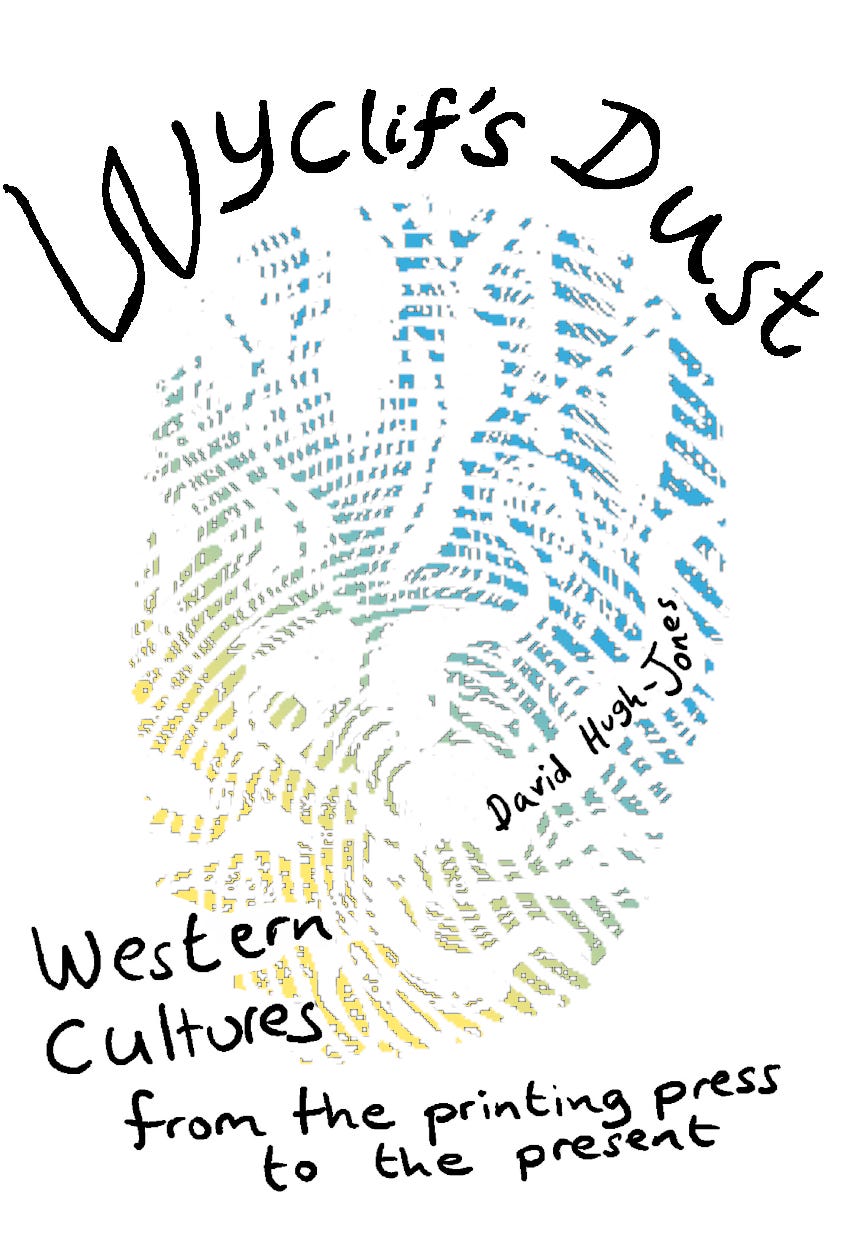The previous three posts in this series presented a mass of data from the European Social Survey and European Values Survey:
Now let’s step back and resolve that data into understandable patterns.
The American story of Coming Apart is that the rich have kept to traditional lifeways — of work, family and religion — whilst the poor have lost them. In the domain of work, this story holds true in Europe too. There has been a sharp drop in full-time employment among the less educated and poor, while it has held steady among the rich and educated. Attitudes don’t necessarily reflect this — the poor are more likely to think that not working makes people lazy, and that work is a duty. This might be a case where the rich are not “preaching what they practise”, in Charles Murray’s phrase.1
But this is the only topic where Coming Apart holds. Looking at marriage, we see a steep increase in unmarried parenthood, including among the rich and educated. Proportionally there is an even steeper increase in never-married parenthood — a doubling or more. And among the educated, this is more common not less: according to the EVS, much more. This is an extraordinary change. In many historical societies, unmarried parenthood has been relatively common among the poor. For it to be this common among the elite is unprecedented.
In terms of attitudes, there’s no obvious pattern between rich and poor. Attitudes have grown more anti-marriage among all groups: there is no “coming apart”.
The conventional story which Charles Murray disputes for American religion is true for Europe. The rich and educated are less religious on every dimension. There are broadly parallel declines, especially in church attendance. The rich start lower, so the proportionate decline is larger. Among university-educated respondents, religious attendance is close to extinct.
Lastly, broadly progressive and/or individualist attitudes have grown and spread from the educated to the less educated and from rich to poor. Where change has been in the opposite direction, from progressive to traditional — as for tolerance of lying and adultery, and national pride — the movement has been in the direction favoured by the poor and less educated. When I say “spread”, I’m being a bit loose: nothing in the data tells us the exact process by which people’s attitudes are changing. But the direction of change is towards rich people’s attitudes where it is towards progressivism, and towards poor people’s attitudes where it is towards traditionalism.
As an aside, working with these surveys reminded me of a line from a black lesbian feminist in the 1970s: “the master’s tools will never dismantle the master’s house.” Data on attitudes is not theory-free. The questions in these surveys are indirectly descended from Ronald Inglehart’s work on value change. Writing in the 1970s, Inglehart thought the world was changing from materialist values centered on work and security to post-materialist values centered on self-expression and freedom. This is itself a progressive idea. (Since then, Inglehart has modified his theory ex post, adding an “authoritarian backlash” to explain why history hasn’t gone the way he expected.) Any conservative engaging with social science data is to some extent forced to use the enemy’s tools. It would be nicer to have questions derived from our own theories. But you work with what you’ve got.
Understanding European value change
How do these broad changes relate to the anecdotes I started with, the official graffiti artist and the hip-hop DJ who is a bishop’s son? And what about the still broader notion of “cultural surrender”?
I think of two underlying processes as driving the value and behaviour changes we see. One is dechristianization. The decline of Christianity as a shared moral framework has been ongoing for at least two centuries. Because shared ideas can be more powerful than clever ideas, Christianity could survive its initial attacks from Enlightenment philosophes and even stage a comeback in the 19th century. But the challenge was renewed by the scientific and biblical discoveries of that century, from Darwin to David Strauss. The link from European dechristianization to declining religious belief and attendance is obvious. But Christianity also underpinned other traditional attitudes, including (as Weber argued) attitudes to work and worldly success, and of course the value of the family.
C.S. Lewis famously said that when people stop believing in God, they don’t believe in nothing, they believe in anything. This is more than a snarky comment on the popularity of horoscopes. It sums up the last century of Western culture. When one long-standing framework is lost, people cast around for alternative beliefs.
The other process is democratization. Start from two basic ideas about society. The first is that democracy genuinely empowers the majority: the people rule. Democracies have large, chronic redistribution of wealth down the social scale, and mass provision of goods like education. Theories of democracy in which elites secretly get their own way will always find plenty of supporting anecdotes, because voters are not good at paying attention. But as an overall framework, they miss the wood for the trees.
The second basic idea is that cultural influence follows power. When Britain was powerful, British culture exerted a global pull. American culture is fascinating now for the same reason. And in democracies, where the people rule, they are culturally decisive too.
In George Bernard Shaw’s 1913 play Pygmalion, a professor and a colonel try to transform an East End flower girl into a respectable person of the same class as themselves. They fail when it turns out that Eliza Doolittle has her own desires and preferences, and doesn’t want to be remoulded. This is a metaphor for the previous century of sustained effort by the European bourgeoisie to improve the moral condition of the working classes — to make “them” more like “us”. But the growing political power of the masses eventually overrode these attempts, which anyway had lost self-assurance because of bourgeois uncertainty about their own values, see above.
What kind of value framework results from these two processes, and why are the results different in Europe and America?
A set of different influences formed the values of the post-war European middle class:
The remaining influence of historic middle class values. These should not be underestimated: value change is not overnight, many values are transmitted from parents to children, and traditional institutions like churches still had an influence although it was declining.
Mass media and entertainment culture.
American youth culture, from music to styles of dress.
Consumerism, advertising and brand values.
Secular ideologies transmitted in schools and universities.
All of these overlapped to some extent. TV serials were funded by corporate advertising, for instance, but might also echo secular ideologies by introducing feminist or anti-racist themes.
There are some plausible reasons why value change should be sharper and more widespread in Europe than in the US. First, the US economy is more dynamic and has a smaller welfare state. Insofar as traditional values are geared to success in a market economy, European individuals saw less benefit from holding on to them. But, since attitudes to work are the attitude where we see least difference between the US and Europe, that may not be a very strong effect.
Second, European Christianity was tied more closely to old authoritarian structures that were seriously weakened over the 20th century. US Christian churches had always competed in a religious “open market”. Many European states had a state monopoly religion, whether Anglican, Lutheran or Catholic. Until fairly recently, the persistence of US Christianity made it an exception to the general rule of secularization.
A picture of the contemporary middle class
But the reasons why it has happened are less important than the fact that it has happened. The values that exist at the bottom of society in America are, to some degree, shared across the whole of society in Europe. Let me try to put some flesh on dry statistical bones, by describing the ideas and attitudes of the people around me. This is necessarily subjective and unrepresentative, but I don’t think my sample of acquaintances is especially unusual. The one exception is age: I know much more about my middle-aged contemporaries (45-55, say) than about younger ones.
In terms of family, they view marriage as a “nice to have”. In particular, it’s not compulsory before having children, though after having children, couples may get married so as to please their parents. Since the marriage market is dysfunctional, women may have children on their own if they haven’t found someone by their 40s and if they can afford to.
Apart from a tiny, typically non-Christian minority, they are not religious in faith or practice. They are ignorant of Christianity: I think few could name the Ten Commandments. In this sense they probably know less about Christianity than, say, an illiterate peasant of three centuries ago, who would have been catechized. They are aware of other religions; at the high end, they probably wish each other happy Eid or Hannukah when appropriate. Lower down the social scale, they might, say, have an interest in Wicca.
Attitudes to drink and drugs vary a lot. Hard drug use is probably quite rare, but plenty of people in their 40s smoke weed.
They are culturally eclectic, as likely to enjoy football as opera. They express snobbery less by following high culture in the traditional sense, than by having refined tastes in media (The White Lotus, say).
Politically they have often kept the attitudes of their youth. This doesn’t just mean that they have stayed left wing. They think of politics as fundamentally expressive. It is a way of attitudinizing rather than of getting things done. Their core image of politics is the protest march — a tactic of powerless outsiders — not the committee meeting. They may like to think of themselves as anti-police.
This is more a matter of public culture than of individual attitudes, but they do not admire what used to be called “the great and good”, i.e. public figures, politicians or businesspeople. In keeping with democratic culture, they admire two traditionally low-status categories: outsiders and rebels, and ordinary Joes. Outsiders are admired because they are seen as unconventional and transgressive, which brings us back to the official town graffiti artist (see also Banksy). Ordinary Joes are authentic and down-to-earth. I would speculate that the prestige of the rebel was at its peak slightly earlier, when there was a more definite traditional culture to rebel against.
The last two points mean that the middle class is deeply unassertive. They don’t publicly believe in the values they actually strive for (success and social status). In this sense it’s the same as the US, they don’t “preach what they practice”. But they also literally have no way to publicly articulate what they are doing: they don’t believe it themselves. And they don’t know how to organize politically to get what they want. As a result, their fundamental way of dealing with bad behaviour, at all levels, is avoidance not challenge. If a neighbourhood is dirty and dangerous, or the children in a school are semi-criminal, they will solve their problem by finding a different neighbourhood or school. The assertiveness of Pygmalion has been replaced by the Great Sorting Out. Of course, middle class people will feel bad about the highly stratified society that results.
This is a very rough and incomplete sketch of today’s middle class values, but it already raises serious questions. The argument of Coming Apart is that the American elite should “preach what they practise”, so as to encourage the worse-off half of America to adopt lifeways which are capable of sustaining society. If I am right, this option is not really open to European society, because those lifeways no longer exist among the middle class either. There is essentially no social basis from which good practice can spread.
And from the picture given here, I would be very uncertain about two questions: first, about the new middle class’s ability to sustain a democracy. We have seen in America just how quickly democratic guardrails can fall apart, and a key role is played by the absence of pressure from below. (Here’s an interesting example: when Nixon tried to cancel the Watergate enquiry, he received millions of letters of protest. Trump’s egregious self-dealing and corruption seems to have elicited a much weaker public democratic response.)
Second, I would worry about the middle class’s ability to sustain a society at all. Birth rates have been below replacement for generations in Europe. Part of this is down to institutions — easy divorce lowers the birth rate, and so do state pensions (rather than having children to support their retirement, people can rely on other people’s children in the form of the taxpayer). But culture and attitudes probably also play a role. It seems unlikely that current European cultural values are compatible with a stable population.
If you think this is interesting, why not become a paid subscriber? About half my posts are paid or partly paid. A subscription costs just £3.50/month, and yearly subscribers get a great big 40% discount, plus a free copy of my book.
One worry about this result is that “income is endogenous”. That is, obviously people who do more paid work will have more money, other things being equal, so perhaps the results split by income aren’t informative. Indeed, if I instead split working-age men up by the occupational class of their father (from 1 professional to 8 unskilled manual), we see much less of a pattern in short and long hours:
But this data isn’t perfect either; maybe parent’s class just isn’t a very good predictor of one’s own position.









The world you're describing is more or less the world around me and my friends, and we're doing... fine enough I guess? Your description is accurate enough, but why the negativity? What "enemy" did we surrender to? I'm writing this as a GenX from Catalonia, Spain, to be clear — Europe is not a monolith.
Take marriage; you know the meme, "I love you so much that I'm going to summon the power of the state to tie you to me". People my generation, and maybe even 10-15 years before, started losing the association that formal marriage made the couple real. And they did... plenty OK enough. People still pair up, many still go for long-term relationships, the lifelong thing is no longer the rule, but 15-20 years is still pretty common, and they manage, just like any couple, formally married or not, because the real job is to figure out how to grow together, whether you signed a marriage or a civil partnership or nothing much. There's still about as many men as women, and as far as I can see, we're mostly managing to find each other.
You say the marriage market is "dysfunctional", but given the aggregate differences between men and women, has it ever not been so? Or were people just putting up in silence? The big difference I can see these days is that people no longer need to put up with an abusive partner, or a useless one. And that seems to be mostly on the side of women dropping men who are not up to the job. That strikes me as a good thing all things considered; these guys are being invited to step up, and if they don't, then staying apart is probably the least dysfunctional outcome. Three cats beats an abusive husband, or a sexually entitled man-child, every day of the week.
Marriage is also a fashion thing. Nowadays it's kinda back in fashion, people whose parents didn't bother are now doing big weddings. Good for them if they like it! Fashions go up, fashions go down.
Many people are ignorant about Christianity... maybe they even dabble in horoscopes Wicca or Tarot or Chakra healing. So what? None of these things are literally real, and they all have plenty of use as ways to deal with one's changing emotions and with a changing world. I'd even say that low-status female-coded street spirituality does a better job at this than high religion, which is all tied up in top-down hierarchies with highly dysfunctional authoritarian tendencies.
Then the middle classes don't preach what they practice... welcome to common social hypocrisy? The social world is always a mess, structurally so. We're status-sensitive apes, what can you even expect?
And yeah, birth rates are down. When you give people an actual choice in reproduction, and then create a highly competitive, individualistic world with ever growing expectations on parents, then few people find themselves up for the job!